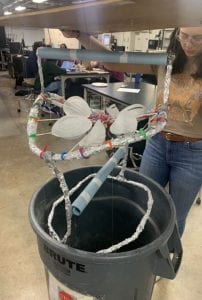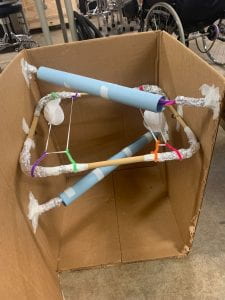Project Progress
Wow, I can’t believe another week has already passed and that we are over one-third done with the internship! This week was busy, but also very exciting. One of the first things we did was come up with a team name – we decided upon Now UV Me, Now U Don’t! In the beginning of our week, we spent quite a bit of time continuing to research aspects of the project, specifically materials which we could use in constructing our physical device. Figuring out which materials are available locally has been a big challenge for our team, and has demonstrated the importance of communicating with our clients/partners, as they have the best sense of what is and is not feasible for their settings.
As we wrapped up the majority of our research, our team also began to define our design criteria. Once our design criteria were defined, we used a Pairwise Comparison Chart (PCC) to compare the importance of the design criteria against one another and rank them in order of importance. Our final design criteria, based on the major goals outlined by our clients last week, include (from most to least important):
- Maximum efficiency of sterilization
- Maximum sustainability of power
- Maximize sustainability of materials
- Maximize usability
- Maximize longevity
- Maximize portability/mobility
- Minimize cost of manufacturing
Overall, while the criteria themselves were fairly well-outlined from our initial interviews and research, the hard part was coming up with quantitative goals for each one. For example, what defines a material as “sustainable,” and how do you quantify how sustainable it is? We had many long discussions within our team and with our TAs and mentors in order to solve these issues.
One of the parts of the week that I considered most exciting with regards to our team’s progress was brainstorming ideas for our solution. Not only was it fun to come up with and share my own ideas, but it was also very inspiring to hear my teammates’ ideas; I found it fascinating to see how many different approaches we were each able to think of, and how many great solutions we were able to come up with by combining these approaches. Perhaps even more fun was the fact that, after using screening and scoring matrices to narrow down our ideas, we began making low-fidelity prototypes for our two highest-scoring ideas.
Prototype 1 (“Carl”):
This prototype is based off of a design which will ultimately use a 55 gallon oil drum (represented by the cylindrical trash can) as the base/shell, and which will contain a removable frame inside which holds layers of mask-holding rings and UV lights. The frame is attached to a lid, so that when the lid is lifted, the frame can be removed. Though the use of the oil drum will make this device very convenient, the biggest challenge will be finding a way to take the frame all the way out of the device easily (given the height of the oil drum) to replace the masks.
Prototype 2 (“Geraldine”)
This prototype, unlike the first design, is in a box-shape (which will likely ultimately be made of sheet metal). Once again, there are layers of UV lights and mask-holding frames. However, for this prototype, the lights are fixed, and just the mask holders can be taken in and out of the box. This would allow for very easy mask replacement.
Overall, I’m very proud of my team’s progress this week! In the coming days, we will continue finalizing our low-fi prototypes, working through some possible solutions to current issues with them, and potentially starting some preliminary usability testing. We will also discuss our solutions with our international clients to get their feedback.
Non-Project Reflections
Not only did our team have a busy week working on our project, but we also attended a number of extremely impactful workshops. Associate Dean Catherine Clark gave us two very particularly engaging and memorable workshops, one on having difficult conversations and one on microaggressions. The difficult conversation workshop was something that I think will almost certainly prove to be useful to me in the future. I am inherently very non-confrontational, and while this isn’t necessarily always a bad thing, it can also prevent me from advocating for both myself and others. Associate Dean Clark touched on the importance of difficult conversations and provided us with a number of strategies for engaging people in them, which I am excited to try in the future. Furthermore, her workshop on microaggressions was definitely very eye-opening. She showed us many videos and gave us numerous examples of microaggressions, all of which were simultaneously unintentional and extremely harmful. It’s scary to think that we all have such ingrained biases that, even if we are completely well-intentioned, we can easily say something that deeply hurts others. However, I think by learning to recognize these microaggressions, I will hopefully be able to stop myself from committing them; by learning to recognize my biases (even if I can’t completely eliminate them), I can hopefully stop myself from acting on them.
Furthermore, workshops by Jake Johnston (Rice 360 technology team) on designing for usability and by Magdah (one of our TAs) on a Biosocial Approach to Engineering highlighted many important considerations to be made during the engineering design process which may often be overlooked. I think the lessons I took away from these workshops will be important on my current project, especially the importance of considering the context in which you are designing and being sure to talk to and interact with users throughout the entire design process. This may be slightly difficult given our current remote environment and inability to interact with our users in-person, which means our team will have to be very consciously aware of connecting with and involving users as much as possible remotely.

